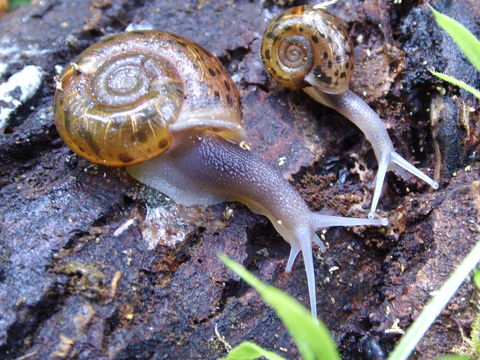Reproduction
Since our snail, Patera panselenus, has unknown specifics for its species, we will be discussing the reproduction of Patera panselenus's family (Polygyridae)(Hickman et al., 2011).
The class Gastropoda is known to be both dioecious and hermaphroditic (also known as monoecious) (Hickman et al., 2011). When a species is dioecious it is an organism with two separate sexes (male and female) having their own separate reproductive organs. Hermaphrodites are organisms which possess both male and female reproductive organs, meaning they can produce sperm and eggs which have the capability of being fertilized or fused together (Nordsieck, 2012).
In most cases, terrestrial snails are classified as being hermaphrodites (Nordsieck, 2012). Being hermaphroditic does not mean that this specific snail only self-fertilizes but it can also cross-fertilize with other members of its species to encourage genetic diversity (Hickman et al., 2011). During the time of sexual reproduction each partner is responsible for playing both female and male roles (Martin, 2000). To reproduce sexually, the snail produces and deposits bundles of sperm which are called spermatophores (Hickman et al., 2011). The spermatophores are formed at the very tip of the male reproductive organ, the penis (Webb, 2012). Snails exchange spermatophores in order to not self-fertilize (Webb, 2012). They mate sexually when conditions are in their favor or when they come across another member of its species (Hickman et al., 2011). Self-fertilizing typically occurs when living conditions are not in their favor, meaning dry weather (Hickman et al., 2011).

Being that Patera panselenus is a terrestrial snail they lay their eggs, which is known as being oviparous (Martin, 2000). They lay these eggs in dark locations such as logs, rocks, and in soil (Martin, 2000). The eggs are usually found borrowed and covered where ever they are laid (Gugler, 2012). Eggs from the family Polygyridae are normally white in color and also have a very flexible shell rather than hard (Gugler, 2012). They get some of their flexibility from a layer of a jellylike substance on the outside of the egg (Gugler, 2012).When these eggs hatch they will be a juvenile versions of the adult snail skipping any larval stages, which is defined as a direct life cycle (Hickman et al., 2011).